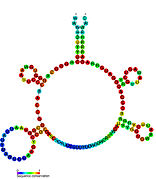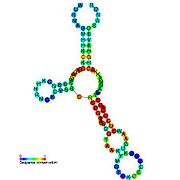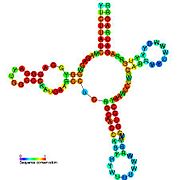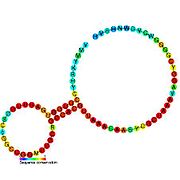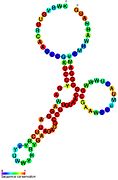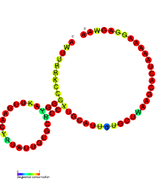Riboswitch

In molecular biology, a riboswitch is a regulatory segment of a messenger RNA molecule that binds a small molecule, resulting in a change in production of the proteins encoded by the mRNA.[1][2][3][4] Thus, an mRNA that contains a riboswitch is directly involved in regulating its own activity, in response to the concentrations of its effector molecule. The discovery that modern organisms use RNA to bind small molecules, and discriminate against closely related analogs, expanded the known natural capabilities of RNA beyond its ability to code for proteins, catalyze reactions, or to bind other RNA or protein macromolecules.
The original definition of the term "riboswitch" specified that they directly sense small-molecule metabolite concentrations.[5] Although this definition remains in common use, some biologists have used a broader definition that includes other cis-regulatory RNAs. However, this article will discuss only metabolite-binding riboswitches.
Most known riboswitches occur in bacteria, but functional riboswitches of one type (the TPP riboswitch) have been discovered in archaea, plants and certain fungi. TPP riboswitches have also been predicted in archaea,[6] but have not been experimentally tested.
History and discovery
Prior to the discovery of riboswitches, the mechanism by which some genes involved in multiple metabolic pathways were regulated remained mysterious. Accumulating evidence increasingly suggested the then-unprecedented idea that the mRNAs involved might bind metabolites directly, to affect their own regulation. These data included conserved RNA
Many of the earliest riboswitches to be discovered corresponded to conserved sequence "motifs" (patterns) in 5' UTRs that appeared to correspond to a structured RNA. For example, comparative analysis of upstream regions of several genes expected to be co-regulated led to the description of the S-box[15] (now the SAM-I riboswitch), the THI-box[9] (a region within the TPP riboswitch), the RFN element[8] (now the FMN riboswitch) and the B12-box[16] (a part of the cobalamin riboswitch), and in some cases experimental demonstrations that they were involved in gene regulation via an unknown mechanism. Bioinformatics has played a role in more recent discoveries, with increasing automation of the basic comparative genomics strategy. Barrick et al. (2004)[17] used BLAST to find UTRs homologous to all UTRs in Bacillus subtilis. Some of these homologous sets were inspected for conserved structure, resulting in 10 RNA-like motifs. Three of these were later experimentally confirmed as the glmS, glycine and PreQ1-I riboswitches (see below). Subsequent comparative genomics efforts using additional taxa of bacteria and improved computer algorithms have identified further riboswitches that are experimentally confirmed, as well as conserved RNA structures that are hypothesized to function as riboswitches.[18][19][20]
Mechanisms
Riboswitches are often conceptually divided into two parts: an aptamer and an expression platform. The aptamer directly binds the small molecule, and the expression platform undergoes structural changes in response to the changes in the aptamer. The expression platform is what regulates gene expression.
Expression platforms typically turn off gene expression in response to the small molecule, but some turn it on. The following riboswitch mechanisms have been experimentally demonstrated.
- Riboswitch-controlled formation of rho-independent transcription terminationhairpins leads to premature transcription termination.
- Riboswitch-mediated folding sequesters the translation.
- The riboswitch is a ribozyme that cleaves itself in the presence of sufficient concentrations of its metabolite.
- Riboswitch alternate structures affect the splicingof the pre-mRNA.
- A riboswitch in Clostridium acetobutylicum regulates an adjacent gene that is not part of the same mRNA transcript. In this regulation, the riboswitch interferes with transcription of the gene. The mechanism is uncertain but may be caused by clashes between two RNA polymerase units as they simultaneously transcribe the same DNA.[24]
- A riboswitch in Listeria monocytogenes regulates the expression of its downstream gene. However, riboswitch transcripts subsequently modulate the expression of a gene located elsewhere in the genome.[25] This trans regulation occurs via base-pairing to the mRNA of the distal gene. As the temperature of the bacterium increases, the riboswitch melts, allowing transcription. Unpublished undergraduate research created a similar riboswitch or 'thermosensor' via random mutagenesis of the Listeria monocytogenes sequence.[26]
Types
The following is a list of experimentally validated riboswitches, organized by ligand.
- cobalaminbiosynthesis and transport of cobalamin and similar metabolites, and other genes.
- cyclic AMP-GMP riboswitches bind the signaling molecule cyclic AMP-GMP. These riboswitches are structurally related to cyclic di-GMP-I riboswitches (see also "cyclic di-GMP" below).
- cyclic di-AMP riboswitches (also called ydaO/yuaA) bind the signaling molecule cyclic di-AMP.
- cyclic di-GMP riboswitches bind the signaling molecule cyclic di-GMP in order to regulate a variety of genes controlled by this second messenger. Two classes of cyclic di-GMP riboswitches are known: cyclic di-GMP-I riboswitches and cyclic di-GMP-II riboswitches. These classes do not appear to be structurally related.
- fluoride riboswitches sense fluoride ions, and function in surviving high levels of fluoride.
- FMN riboswitch (also RFN-element) binds flavin mononucleotide (FMN) to regulate riboflavin biosynthesis and transport.
- glmS riboswitch, which is a ribozyme that cleaves itself when there is a sufficient concentration of glucosamine-6-phosphate.
- Glutamine riboswitches bind glnA RNA motif and Downstream-peptide motif. These classes are believed to be structurally related (see discussions in those articles).
- Glycine riboswitch binds glycine to regulate glycine metabolism genes, including the use of glycine as an energy source. Previous to 2012, this riboswitch was thought to be the only that exhibits cooperative binding, as it contains contiguous dual aptamers. Though no longer shown to be cooperative, the cause of dual aptamers still remains ambiguous.[27]
- Lysine riboswitch (also L-box) binds lysine to regulate lysine biosynthesis, catabolism and transport.
- manganese riboswitches bind manganese ions.
- NiCo riboswitches bind the metal ions nickel and cobalt.
- PreQ1 riboswitches bind pre-queuosine1, to regulate genes involved in the synthesis or transport of this precursor to queuosine. Three entirely distinct classes of PreQ1 riboswitches are known: PreQ1-I riboswitches, PreQ1-II riboswitches and PreQ1-III riboswitches. The binding domain of PreQ1-I riboswitches are unusually small among naturally occurring riboswitches. PreQ1-II riboswitches, which are only found in certain species in the genera Streptococcus and Lactococcus, have a completely different structure, and are larger, as are PreQ1-III riboswitches.
- Purine riboswitches binds purines to regulate purine metabolism and transport. Different forms of the purine riboswitch bind guanine (a form originally known as the G-box) or adenine. The specificity for either guanine or adenine depends completely upon Watson-Crick interactions with a single pyrimidine in the riboswitch at position Y74. In the guanine riboswitch this residue is always a cytosine (i.e. C74), in the adenine residue it is always a uracil (i.e. U74). Homologous types of purine riboswitches bind deoxyguanosine, but have more significant differences than a single nucleotide mutation.
- S-adenosylmethionineis used in methylation reactions.
- SAM riboswitches bind Lactobacillales. These three varieties of riboswitch have no obvious similarities in terms of sequence or structure. A fourth variety, SAM-IV riboswitches, appears to have a similar ligand-binding core to that of SAM-I riboswitches, but in the context of a distinct scaffold.
- methionine adenosyltransferase, it was proposed that only their binding to SAM is physiologically relevant.
- tetrahydrofolateto regulate synthesis and transport genes.
- thiamin biosynthesis and transport, as well as transport of similar metabolites. It is the only riboswitch found so far in eukaryotes.[28]
- ZMP/ZTP riboswitches sense ZMP and ZTP, which are by-products of de novo purine metabolism when levels of 10-Formyltetrahydrofolate are low.
Presumed riboswitches:
- Moco RNA motif is presumed to bind molybdenum cofactor, to regulate genes involved in biosynthesis and transport of this coenzyme, as well as enzymes that use it or its derivatives as a cofactor.
Candidate metabolite-binding riboswitches have been identified using bioinformatics, and have moderately complex
Computational models
Riboswitches have been also investigated using in-silico approaches.[29][30][31] In particular, solutions for riboswitch prediction can be divided into two wide categories:
- riboswitch gene finders, i.e. systems aimed at uncovering riboswitches by genomic inspections, mostly based on motif-searching mechanisms. This group contains Infernal, the founding component of the Rfam database,[32] and more specific tools such as RibEx[33] or RiboSW.[34]
- conformational switch predictors, i.e. methods based on a structural classification of alternative structures, such as paRNAss,[35] RNAshapes[36] and RNAbor.[37] Moreover, family-specific approaches for ON/OFF structure prediction have been proposed as well.[38]
The SwiSpot tool[39] somehow covers both the groups, as it uses conformational predictions to assess the presence of riboswitches.
The RNA world hypothesis
Riboswitches demonstrate that naturally occurring
As antibiotic targets
Riboswitches could be a target for novel antibiotics. Indeed, some antibiotics whose mechanism of action was unknown for decades have been shown to operate by targeting riboswitches.[41] For example, when the antibiotic pyrithiamine enters the cell, it is metabolized into pyrithiamine pyrophosphate. Pyrithiamine pyrophosphate has been shown to bind and activate the TPP riboswitch, causing the cell to cease the synthesis and import of TPP. Because pyrithiamine pyrophosphate does not substitute for TPP as a coenzyme, the cell dies.
Engineered riboswitches
Since riboswitches are an effective method of controlling gene expression in natural organisms, there has been interest in engineering artificial riboswitches[42][43][44] for industrial and medical applications such as gene therapy.[45][46]
See also
- RNA thermometer - Another class of mRNA regulatory segments which change conformation in response to temperature fluctuations, thereby exposing or occluding the ribosome binding site.
References
- PMID 14729327.
- PMID 15919195.
- PMID 14698618.
- PMID 16707260.
- ^ PMID 12323379.
- PMID 12756322.
- PMID 10852957.
- ^ PMID 10529804.
- ^ PMID 11470904.
- PMID 11504932.
- PMID 8990161.
- PMID 12464185.
- ^ S2CID 4408592.
- PMID 12456892.
- PMID 10094622.
- PMID 9190822.
- PMID 15096624.
- ^ PMID 16086852.
- PMID 17621584.
- PMID 20230605.
- S2CID 4393918.
- PMID 17993623.
- PMID 18006684.
- PMID 18812398.
- PMID 19914169.
- ^ "Team:BYU Provo/Results - 2011.igem.org". 2011.igem.org.
- PMID 22279151.
- PMID 18778966.
- PMID 19381548.
- PMID 20061789.
- ISBN 978-0-12-801618-3.
- PMID 19307242.
- PMID 15980564.
- PMID 19460868.
- PMID 14962925.
- PMID 25273103.
- PMID 17573364.
- PMID 22537010.
- PMID 27378291.
- PMID 18430893.
- S2CID 34398395.
- PMID 16442180.
- PMID 20133756.
- PMID 20308585.
- PMID 24449891.
- PMID 26137851.
Further reading
- Ferré-D'Amaré, Adrian R.; Winkler, Wade C. (2011). "Chapter 5. The Roles of Metal Ions in Regulation by Riboswitches". In Astrid Sigel, Helmut Sigel and Roland K. O. Sigel (ed.). Structural and catalytic roles of metal ions in RNA. Metal Ions in Life Sciences. Vol. 9. Cambridge, U.K.: RSC Publishing. pp. 141–173. PMID 22010271.




